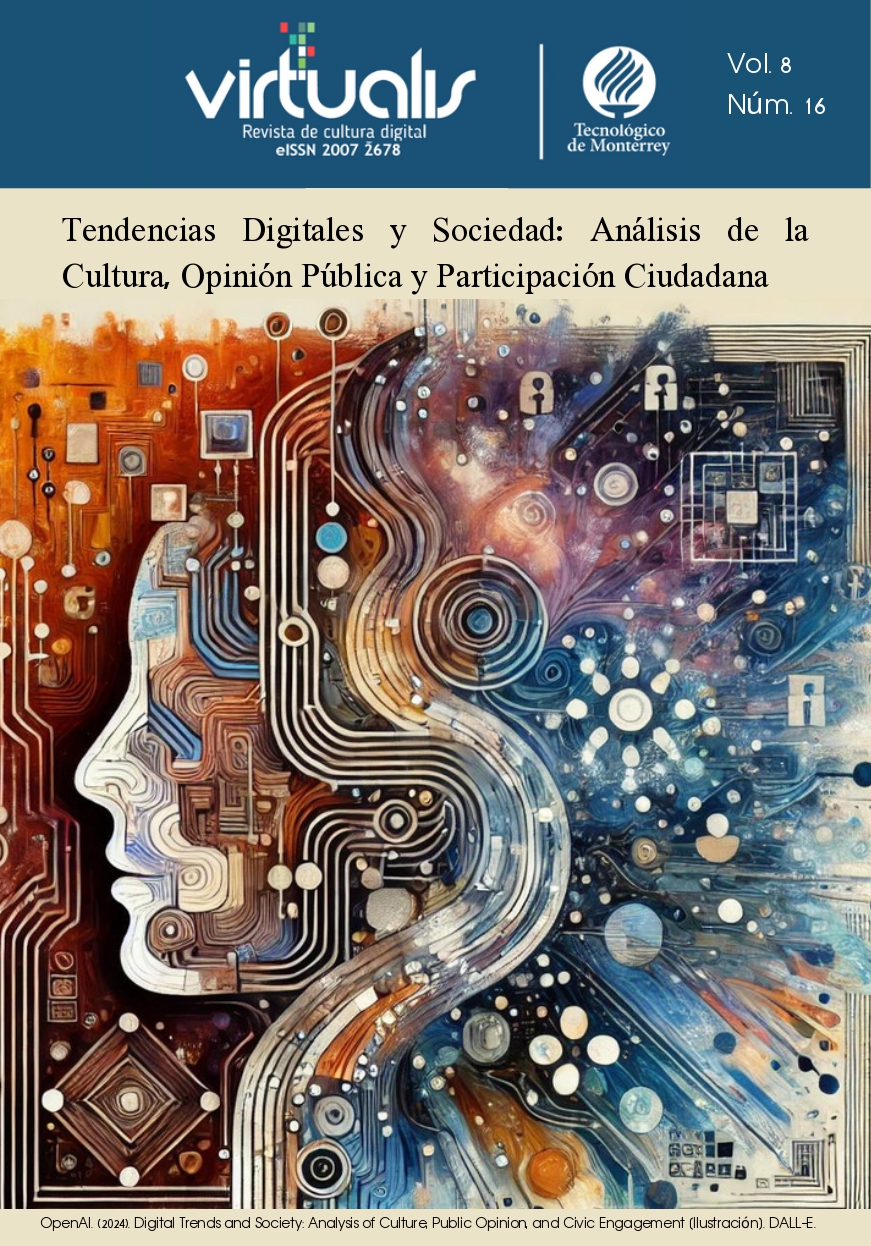¿Quién ganó el debate en el Estado de México? Las encuestas en Twitter como síntoma de posverdad
Contenido principal del artículo
Gayo-Avello, D. (2012). I wanted to predict elections with Twitter and all I got was this
Lousy Paper. A balanced survey on election prediction using Twitter data.
University of Oviedo [En línea]. Recuperado de: https://arxiv.org/pdf/1204.6441.pdf
Grömping, M. (2014). €˜Echo chambers€™ partisan facebook groups during the 2014 thai
election. Asia Pacific Media Educator, 24(1), pp. 39-59.
Habermas, J. (1989). The structural transformation of the public sphere. Cambridge, MA:
MIT Press.
Hannan, J. (2016). Truth as first casualty in american politics. En J. Hannan (Ed.), Truth
in the public sphere (pp. XI-XXXVI). Lanham, MD: Lexington.
Hwang, T., Pearce, I., & Nanis, M. (2012). Socialbots: voices from the fronts. Interactions,
(2), pp. 38-45.
Islas, I. (2014). El debate electoral #Yosoy132: oportunidad de diálogo. Observaciones
desde la teoría de la deliberación. En C. Rodríguez Cano (Ed.), Comunicación en
red: política en movimiento. México: Razón y Palabra. Recuperado
de: http://www.razonypalabra.org.mx/LibroComunicacionRedPolitica/Comunicaci
onRedPoliticaMovimiento.pdf
Iyengar, S., & Hahn, K.S. (2009). Red media, blue media: evidence of ideological
selectivity in media use. Journal of Communication, 59(1), pp. 19-39.
Jensen, K. B., & Rosengren, K. E. (1997). Cinco tradiciones en busca del público. En D.
Dayan (Ed.), En busca del público: recepción, televisión, medios (pp. 335-370).
Metaxas, P.T., & Mustafaraj, E. (2012). Social media and the elections. Science,
(6106), pp. 472-473.
Mitchell, A., Holcomb, J., & Weisel, R. (2016). State of news media 2016. Washington, DC:
Pew Research Center.
Pariser, E. (2011). The filter bubble: What the internet is hiding from you. Londres:
Penguin.
Ratkiewicz, J., Conover, M. D., Meiss, M., Goncalves, B., Flammini, A., & Menczer, F.
(2011). Detecting and tracking political abuse in social media. International AAAI
Conference on Weblogs and Social Media, pp. 249-252 [En línea]. Recuperado de:
https://www.aaai.org/ocs/index.php/ICWSM/ICWSM211/paper/view/2850
Ricaurte, P. (2012). Twitter y el simulacro político. Revista Mexicana de Comunicación
(130) [En línea]. Recuperado de:
http://mexicanadecomunicacion.com.mx/rmc/2012/2006/2019/twitter-y-elsimulacro-
politico/
Romano, A. (2017). Asserting journalistic autonomy in the 'post-truth' era of 'alternative
facts': lessons from reporting on the orations of a populist leader. Asia Pacific
Media Educator, 27(1), pp. 1-16.
Singer, J.B. (2013). User-generated visibility: secondary gatekeeping in a shared media
space. New Media & Society, 16(1), pp. 55-73.
Strong, S.I. (2017). Alternative facts and the post-truth society: meeting the challenge.
University of Pennsylvania Law Review Online, 165, pp. 137-146 [En
línea]. Recuperado de: https://www.pennlawreview.com/online/165-U-Pa-L-Rev-
Online-137.pdf
Stroud, N.J. (2008). Media use and political predispositions: Revisiting the concept of
selective exposure. Political Behavior, 30(3), pp. 341-366.
Suau-Martínez, J. (2015). Citizens and online media participation. attitudes and motivations
towards participatory journalism and other online practices in London and Barcelona
(Tesis de doctorado), Universitat Ramon Llull, Barcelona, Spain.
Sunstein, C.R. (2009). Republic.com 2.0. Princeton, NJ: Princeton University Press.
Trejo, R. (2011). ¿Hacia una política 2.0? Potencialidades y límites de la red de redes.
Nueva Sociedad (235), pp. 62-73.
Varol, O., Ferrara, E., Davis, C. A., Menczer, F., & Flammini, A. (2016). Online humanbot
interactions: detection, estimation, and characterization. Communication of
the ACM, 59(7), pp. 96-104.
Barcelona: Gedisa.
Knobloch-Westerwick, S., & Meng, J. (2009). Looking the other way: selective exposure
to attitude-consistent and counterattitudinal political information.
Communication Research, 36(3), pp. 426-448.
Lippmann, W. (1998). Public Opinion. New Brunswick, NJ: Transaction Publishers.
Lozano, J.C. (2007). Teoría e investigación de la comunicación de masas. México: Pearson
Educación.
Masip, P., Suau-Martínez, J., & Ruiz-Caballero, C. (2017). Questioning the selective
exposure to news: understanding the impact of social networks on political news
consumption. American Behavioral Scientist, pp. 1-20.
Messias, J., Schmidt, L., Oliveira, R., & Benevenuto, F. (2013). You followed my bot!
Transforming robots into influential users in Twitter. First Monday, 18(7) [En
línea]. Recuperado de: http://firstmonday.org/article/view/4217/3700

 Blog
Blog
 Instagram
Instagram
 Google
Google
 Tec de Monterrey
Tec de Monterrey

